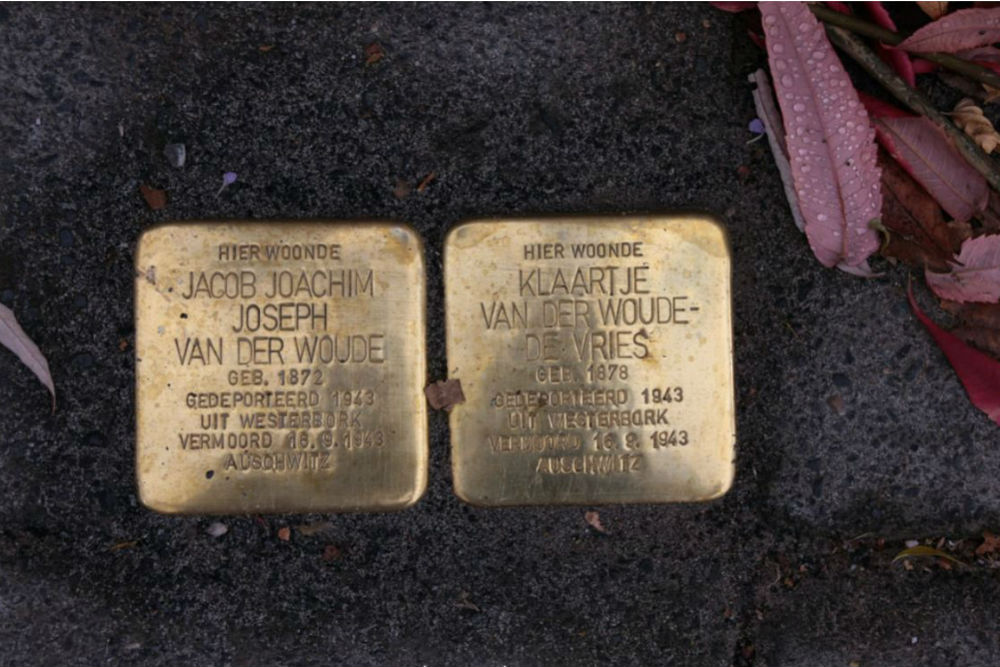Stumbling Stones Taco Mesdagstraat 35
Stolpersteine / Stumbling Stones commemorate:
* Jacob Joachim Joseph van der Woude, born 1872, deported 1943 from Westerbork, murdered 16 September 1943, Auschwitz.
* Klaartje van der Woude-de Vries, born 1878, deported 1943 from Westerbork, murdered 16 September 1943, Auschwitz.
In 1911, Jacob van der Woude, a commercial agent, married Klaartje (Clara) de Vries. They had two daughters: Aaltje (called Ali, born 1912) and Flora Greta (called Florie, born 1915). The family moved to Taco Mesdagstraat in 1923. In 1933, Jacob stopped his work as an agent and planned to live on rental income from 4 large buildings he had aquired over time. He supported the Jewish Territorial Association (part of the movement to establish an autonomous Jewish territory), was chairman of an organization to help poor school children, and was secretary of a Long-term Committee in Groningen. During the war, Jacob worked at the Jewish Council, where he was described as a carefully working, civilized man. He and Clara were sent to Westerbork in February 1943, and then to Auschwitz.
Their younger daughter, Florie, went to Palestine in 1935, married, and returned in 1937, then managed to escape to England in 1940.
Their other daughter, Ali, married the medical doctor Elie Aron Cohen in 1941. The couple moved to Aduard, a village near Groningen and had a son, Aron. In September 1942, they were at Van Brakelplein 45 in Groningen. All three were deported to Westerbork, and then to Auschwitz. Aaltje Cohen-van der Woude and the 4-year-old Aron Elie Cohen were murdered in Auschwitz on 16 September 1943. Aaltje and little Aron are remembered on a monument in Aduard. Elie Aron Cohen survived both Auschwitz and the war, dying in Arnhem at age 84. He wrote a number of books about concentration camps and the "post concentration camp syndrome" in survivors.
"Stolpersteine" is an art project for Europe by Gunter Demnig to commemorate victims of National Socialism (Nazism). Stolpersteine (stumbling stones) are small, 10x10cm brass plaques placed in the pavement in front of the last voluntary residence of (mostly Jewish) victims who were murdered by the Nazis. Each plaque is engraved with the victimís name, date of birth, and place (mostly a concentration camp) and date of death. By doing this, Gunter Demnig gives an individual memorial to each victim. One stone, one name, one person. He cites the Talmud: "A human being is forgotten only when his or her name is forgotten."
Do you have more information about this location? Inform us!
Source
- Text: Anne Palmer
- Photos: Suzanne Matrosov-Vruggink
- Biografie Familie van der Woude
- Stolpersteine.eu
Nearby
Point of interest
- Bullet Impact Taco Mesdagstraat 41 - Groningen
- Bullet Impact Wassenberghstraat 18 - Groningen
- Remembrance place Taco Mesdagplein 13 - Groningen
Monument
- War Monument Schilderswijk - Groningen
- Memorial Post Office Groningen - Groningen
- Memorial Academy Building University - Groningen
Cemetery
- Dutch War Graves Northern Cemetery - Groningen
- Commonwealth War Graves Groningen - Groningen
- Dutch War Graves Zuiderbegraafplaats - Groningen
Remembrance Stone
- Stumbling Stone Taco Mesdagstraat 37 - Groningen
- Stumblingstones Wassenberghstraat 24 - Groningen
- Stumbling Stones Wassenberghstraat 10 - Groningen
Fortification
- German Shelter Suikerunie Factory - Groningen
- German Tobruk Bunker Suikerunie Factory - Groningen
- German Bunker Haren - Haren





